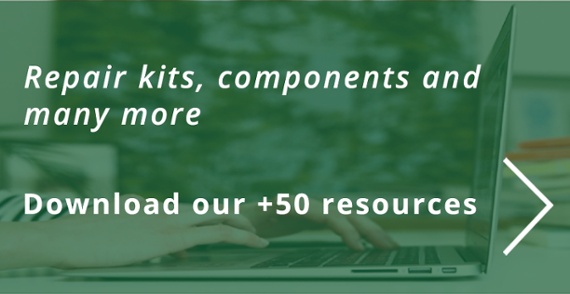
Maybe you've been there: you’ve been driving home and you’ve noticed a vibration in the brake pedal and you may not have given it a thought; or you’ve taken your vehicle to pass the MOT inspection and you did not make it because of the brakes.
As you can imagine, these are some reasons that will force you to check the condition of your car’s brakes, but how do you know if it is better rebuild or replace the brake caliper? In this post we give you the answer.
How to tell if brake calipers are damaged
Brake calipers are parts used to press the brake pads against the brake disc to slow down or stop the vehicle.
Depending on the brand and manufacturer, the average lifespan of a brake disc is between 120,000 and 180,000 kilometres. In general, it is advisable to check the brake calipers and discs after 30,000 kilometres, although it may not yet be necessary to replace them. However, it is essential to make sure that the brake calipers and discs are in perfect condition.
In the event that your clamps are damaged, we may notice a number of indicators. These indicators or signals are as follows:
- Brake lock. This failure causes the vehicle 's steering to wobble. It may be due to a jammed piston, guide or pad due to overheating, deterioration or corrosion of these elements. It is detected by a reduction in speed and increased road noise.
- Partial braking. You will notice a slower than normal response or change of direction. This failure is usually due to incorrect sliding of guides, a component being incorrectly positioned or small leaks in the circuit such as a low brake fluid level.
- No braking. In this case we will not notice any response, it will not slow down. If there is a broken component or brake fluid leakage, this failure will occur sooner or later. This is very dangerous so it is necessary to park your vehicle and call a tow truck.
- Occurrence of noise. The occurrence of noise or vibrations is due to four possible factors:
- Lack of lubrication: The correct amount of grease must be used in the space between the brake pads, the brake pad accessories and the piston surface.
- Elements not completely fixed: Such as plates, sheets or other sliding components.
- Unevenly worn pads: Because it does not slide properly or is completely blocked.
- Brake disc wavy or rusty: If the disc is not correctly positioned, uneven wear may occur. This wear can rub against the brake pads during driving and cause noise.
Why repair a brake caliper first instead of replacing it completely?
We have just seen the different ways in which our vehicle could be warning us that it is time to repair the brake caliper. As you can see, these failures act on the caliper components and not on the entire caliper. In addition, many of the failures are due to deterioration or wear of these components.
You should know that repairs and visits to the workshop can not only be tedious, but can also be very expensive. If you want to avoid these situations, from Frenkit we recommend that, as long as you have the right knowledge and you do it properly with the necessary tools, you can repair your vehicle’s brake caliper yourself. If this is not the case, we recommend that you consult our trusted workshop and have the brake caliper rebuild or, if necessary, replaced.
When repairing our brake system, the manufacturer's maintenance and safety instructions and the specific installation instructions must be observed. Once these instructions are clear to us, we can start with the disassembly of the brake caliper.
Unlike brake discs and brake pads, brake calipers can be replaced individually. In the post on where we talk about the types of brake calipers, we tell you how much money it can cost to change a brake caliper and what types of calipers are available on the market.
Depending on the make and model of the vehicle, the price of a brake caliper rebuild or replace may vary. You can find a range of brake caliper repair kits of the best brands by accessing our online catalogue.
What is a brake caliper repair kit?
In addition to the tools necessary for any repair (wrenches, circlip pliers, hex sockets...) Frenkit recommends using other tools that will make disassembly easier and give a more professional finish if you want to repair the brake caliper yourself:
- Brake caliper brush. This wire brush cleans the brake calipers. Be careful not to damage the sliding areas or internal parts.
- Special tool case, for disassembling the piston with internal components. This case is supplied by Frenkit.


- Brake cleaner, a degreaser that removes residues that appear when the braking system is adjusted.
- Brake fluid. Allows the force of the brake pedal to be transmitted to the wheel cylinders. It is necessary to use the specific fluid that your vehicle uses. Very often during repairs there are fluid leaks so it is advisable to have fluid to refill the circuit.
At Frenkit we specialise in the manufacture and distribution of brake components for vehicles. On our website you can access an extensive catalogue with range kits for your vehicle 's brake and clutch systems.


